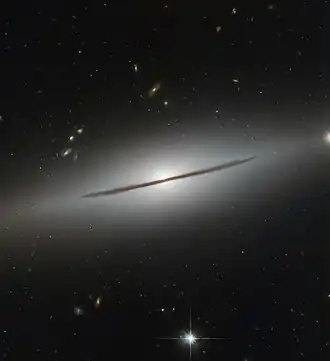NGC 1032
| NGC 1032 | |
|---|---|
 NGC 1032 imaged by the Hubble Space Telescope.[1] | |
| Observation data (J2000 epoch) | |
| Constellation | Cetus |
| Right ascension | 02h 39m 23.6575s[2] |
| Declination | +01° 05′ 37.729″[2] |
| Redshift | 0.009150±0.000012[2] |
| Heliocentric radial velocity | 2,743±4 km/s[2] |
| Distance | 121.0 ± 8.5 Mly (37.09 ± 2.61 Mpc)[2] |
| Apparent magnitude (V) | 12.1B[2] |
| Characteristics | |
| Type | S0/a[2] |
| Apparent size (V) | 3.3′ × 1.1′[2] |
| Other designations | |
| IRAS F02367+0052, 2MASX J02392368+0105376, UGC 2147, MCG +00-07-073, PGC 10060, CGCG 388-086[2] | |
NGC 1032 is a spiral galaxy that is about 121 million light-years away in the constellation Cetus. It was discovered by German-British astronomer William Herschel on 18 December 1783.[3][4]
NGC 1032 is an Active Galaxy Nucleus Candidate, i.e. it has a compact region at the center of a galaxy that emits a significant amount of energy across the electromagnetic spectrum, with characteristics indicating that this luminosity is not produced by the stars.[5]
Supernova
One supernova has been observed in NGC 1032. SN 2005E (type gap, mag. 16.8) was discovered by the Lick Observatory Supernova Search (LOSS) on 13 January 2005. It was initially classified as Type Ib or Type Ic.[6][7] However, later analysis determined that it was instead a calcium-rich supernova (also known as a "gap" transient), a (then) new type of astronomical transient.[8]
References
- ^ "A spiral disguised". ESA Hubble. Retrieved 16 August 2024.
- ^ a b c d e f g h i "NASA/IPAC Extragalactic Database". Results for NGC 1032. Retrieved 2006-11-11.
- ^ Herschel, William (1786). "Catalogue of One Thousand New Nebulae and Clusters of Stars" (PDF). Philosophical Transactions of the Royal Society of London. 76: 457–499. Bibcode:1786RSPT...76..457H. doi:10.1098/rstl.1786.0027.
- ^ Seligman, Courtney. "NGC 1032". Celestial Atlas. Retrieved 16 August 2024.
- ^ "NGC 1032". SIMBAD. Centre de données astronomiques de Strasbourg. Retrieved 6 August 2025.
- ^ Graham, J.; Li, W.; Schwartz, M.; Trondal, O. (15 January 2005). "Supernovae 2004gw, 2005B, 2005D, 2005E, 2005F, 2005G". International Astronomical Union Circular (8465): 1. Bibcode:2005IAUC.8465....1G.
- ^ Bishop, David. "Bright Supernovae 2005, entry for SN 2005E". Rochester Astronomy.org. Retrieved 21 October 2018.
- ^ Perets, H. B. (2010). "A faint type of supernova from a white dwarf with a helium-rich companion". Nature. 465 (7296): 322–325. arXiv:0906.2003. Bibcode:2010Natur.465..322P. doi:10.1038/nature09056. PMID 20485429.
External links
 Media related to NGC 1032 at Wikimedia Commons
Media related to NGC 1032 at Wikimedia Commons- NGC 1032 on WikiSky: DSS2, SDSS, GALEX, IRAS, Hydrogen α, X-Ray, Astrophoto, Sky Map, Articles and images